Verde Rebuild Finishing Up
Jul 02, 2006
I've been extremely bad at updating progress on my project, so
here's the final update.
The weather continued to be nice early but at least I had the
Spider to drive. After that bout of nice weather we started getting rain, lot's
of rain. In fact my town had a number of areas that were flooded out which
hasn't happened before in the 10 years that I've been here. In fact there
are still a couple roads, many weeks later that are in a semi-repaired state but
I digress. Due to the amount of rain I really wanted to get the Verde
going since it was no fun driving the Spider in the rain. To speed things
up I started looking around for a cheap replacement engine I could temporarily
drop in to get me going while I took my time on the rebuild of the original
engine. No Verde engines were showing up, only 2.5's which just wouldn't
do so I started keeping an eye out for a cheap 164. I saw a couple on my
local craigslist but decided that it would be too much work to dispose of the
rest of the car once I pulled the engine. As luck would have it the next day I saw a
164 engine listed on craigslist!
I called the seller immediately and he said it was still
available. The seller was a shop that primarily focused
on two things, souping up Volvos and buying totaled cars that really just needed
some panels replaced. They replace the panels and sell the cars.
They got the 164L from somewhere in Georgia I think he said and the engine was
running fine when they took it out. They had decided to part out the car
about a year ago because a client had needed a new automatic tranny installed so
they took the one out of this car. That same client told them to save the
engine as he wanted it and then never ended up buying it from them. The
engine had been sitting in a corner of the shop for a year and had had a few
parts removed but was essentially intact. The seller said the L it came
out of had about 80K miles on it, a lot less than my Verde engine! The
best part was he only wanted $250 for it! Sold! He helped me load it
into the back of my minivan with the oil pan sitting in a tire, was OK just as
long as I went slow around the curves and on on-ramps. Got it home and
hauled out the cherrypicker to pull it out of the van, here are a few shots of the
engine, looks a little grungy but was actually in quite good condition.
Just to cover my rear here, any mods I did here are not
sanctioned or necessarily recommended by me, this is purely a blow by blow of
what I did to get a 164 engine running in my Verde. Use at your own risk!
Now with that out of the way...
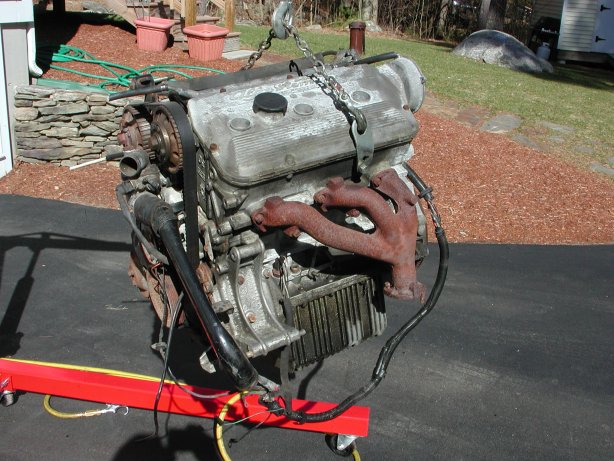
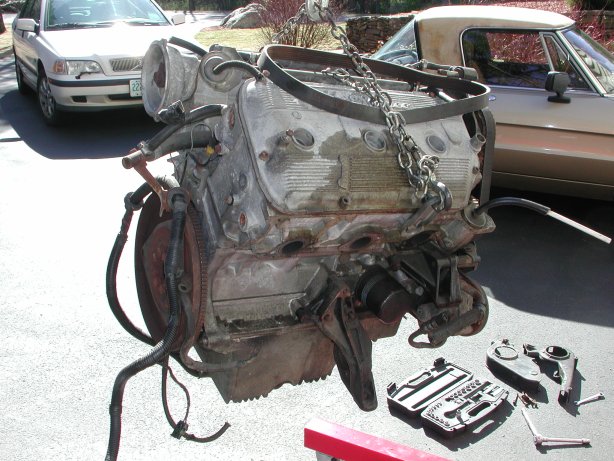

As you can see, there are a number of mods that have to be made but after reading the article on the gtv6 site (http://alfagtv6.com/msdocs/3L_update_Conversion.doc) about a similar conversion of the 164 engine to go into a gtv6 it definitely looked doable. The article is by David Schmidt and he says in it that any part of it can be used for other purpose such as a 164 to 75 swap so I plan to take liberal advantage of that here to save me some typing. I will change the text to match the slight variances that I found but would like to acknowledge the excellent work David did writing this up and making my swap possible, thank you!!!
MOTOR CONVERSION
Removed the following from the 164 engine
- Timing belt covers
- Timing Belt (used the one from the Verde engine as it only had 5K on it)
- Belt de-Tensioner (used the one from the Verde engine as it only had 5K on it)
- Cam Pulley – To remove the FWD upper engine mount
- Water pump
- Flywheel
- Front crank pulley and sensor
- Sump, oil pump and pickup
- Oil level indicator sensor
- Pump Drive/Distributor plate
- Dipstick threaded insert
- Front seal cover (to remove the oil pump hex bolts)
- Fuel rail and Injectors
- Inlet runners (actually my engine didn't come with any, the holes were masked shut)
- Heater hose adapter from the rear of the LH Cylinder head
- engine mount studs
Parts required from the Verde engine
- Sump
- Oil Pump and Pickup
- Flywheel
- Front pulley
- Water pump
- Cam belt covers
- AAV
- Plenum, throttle body, and inlet runner pipes
- Distributor and plug leads
- RH engine mount studs
- AC Compressor and mounting bracket
- Injectors and fuel rail
- Plate for 164 Distributor hole (this plate was on the Verde engine for some reason already, no clue why, but it made the job easier!)
- Dipstick tube
- Cam covers
- Distributor hole cover
- Oil level sensor
- Manifold studs (or buy new ones)
Extra Parts required
- Heater hose adapter
- Extra studs
The 164 engine had quite a few extra studs on it that would get
in the way of some of the components you need to put on so they had to be
removed. I should have take some pictures but didn't, sorry. There
were a few of the studs that were a real pain to get out. Some came out
fairly easily with the standard double nutting technique, others required use of
a stud remover which ends up destroying the stud by cutting grooves into the
thread. A couple were even more stubborn and broke so I had to cut them
off. Here's some info from the article with a few pictures.
With the 3.0L coming from a FWD there were a few mods required to allow the fit into the GTV6.
The studs for the FWD top engine mount were removed and replaced with hex plugs as one
hole goes through to the tappet area. One of the holes is required to mount the
2.5L cam belt cover. The problem being the bolt removed is 8mm and the bolt
holding the cam belt cover is 6mm. By carefully drilling out the threaded end of
a 8mm bolt, a 6mm thread can be tapped inside. Cut a slot across the newly made
threaded sleeve and cut off the thread to the require length and screw in into
the 8mm hole. The standard 6mm cam belt cover bolt will then screw straight in.
I didn't bother plugging the holes that didn't punch through, where David had to go to
some trouble to create the cam cover bolt hole I just used the one already on
the Verde head, see below (pic on left is the Verde, one on right is the 164).
I honestly can't remember whether I did anything to the one on the top or not, I
might not have as the hole looks about the right size in the picture.


Now back to the article... All the spare studs were removed from the LH & RH side of the engine. I think these were the original alternator and power steering pump mounts. Hex plugs were installed in these holes as well although probably not essential. Some or these were tough to remove but with high tensile locknuts and vice grips, all eventually came out. The longer engine mount studs on the RH side were replaced with the shorter studs from the 2.5L. The two pictures that follow are from the article, not from my 164 engine, but they were the same on mine.
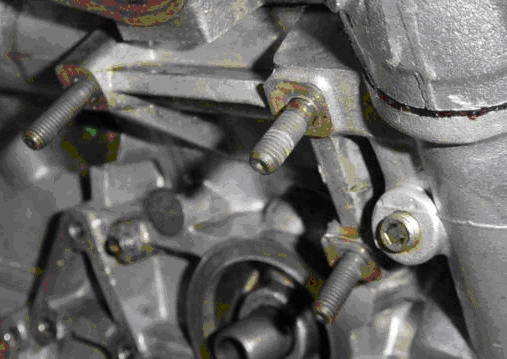

In addition there were a number of brass inserts pushed into some of the holes on the 164 engine that I needed to remove to get the various components to fit right, David didn't mention this so I'm not sure whether he had to remove them or not. There were two types, the smaller thicker ones around the engine mount studs and the larger thinner ones in a couple other places on the block. Most of them were stuck in pretty well and wouldn't come out by pulling with pliers so I got a drill bit slightly larger than the inner diameter of the insert and went at it with the drill. After doing this they would come out pretty easily. Here's a pic of the smaller thicker type near the engine mount studs and one of the larger thinner type near the oil level sensor.
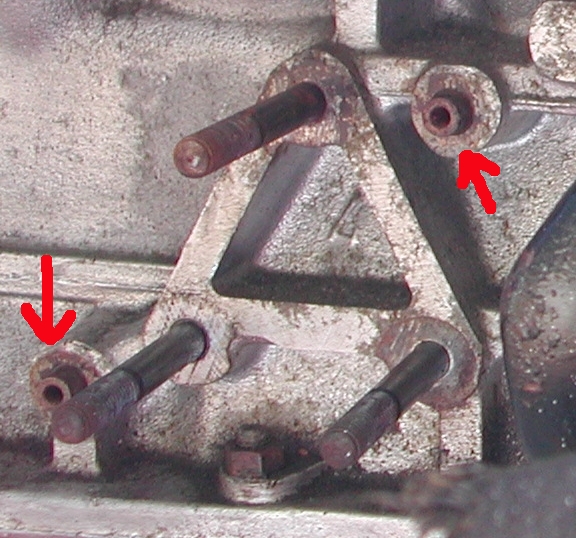

In the article David used his 2.5L flywheel and a spacer. I just used my Verde flywheel and it fit
perfectly.
Sump and Oil Pump
From the article again:
My first task was to remove the sump, oil pump and pickup and replace it with the 2.5L parts. Keep plenty of
paper/rags/etc on the floor under the motor as oil seems to run out continually
as the motor is rotated on the engine stand. The oil pump must be changed as the
164 oil pump drive shaft has a nut and washer to hold the cam shaft driving gear
in place. In the 2.5 this gear is held in place by the distributor. The oil pump
and pickup fitted without a problem although the front crankshaft seal cover has
to be removed to get the oil pump hex studs out. The sump did require
re-alignment of the two centre rear pan bolts about 4mm toward the front of the
motor. This was achieved using a small round file. There’s plenty of bolt
surround on the sump pan to do this without weakening the bolt area. Using a
combination of 7mm bolts & nuts from both the 2.5 & 3.0, suitable length
bolts/studs can be used to bolt up the sump. I did have to remove some metal on
the block just below the engine mounts as there is not enough room to install a
bolt of the correct length to the sump pan in this spot. A stud in lieu of the
through-bolt may solve this but I wasn’t going to remove the sump just to get
these bolts in.
I found out after bolting up the sump pan that the rear edge needed machining back a
little. I used a burring tool and a belt sander to achieve this. I would be much
easier to do this before fitting the sump. I should have done a bit more reading
on the GTV6 site as this was covered in one discussion.
Using the Verde's oil pan I didn't find that I had to machine the rear but I did have to modify the rear
holes a little bit to get the bolts to go in properly. The oil pump went
in without a fuss. Removing the front cover really does make getting the
oil pump bolts in easier but I was able to do it without removing the cover.
Ended up replacing the front cover with the one from the Verde anyway so it was
wasted extra effort to save nothing!
Oil Dipstick
David just used the dipstick that came with his 164 engine. That was one of the parts that was missing on
mine and of course the Verde one was different so I removed the threaded insert
used for the 164 one and replaced it with the threaded tube from the Verde.
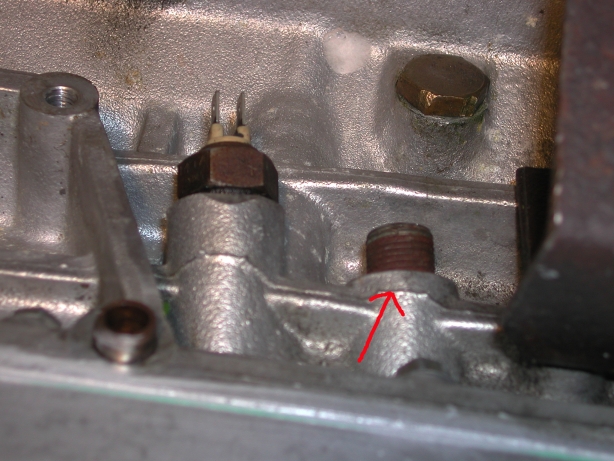
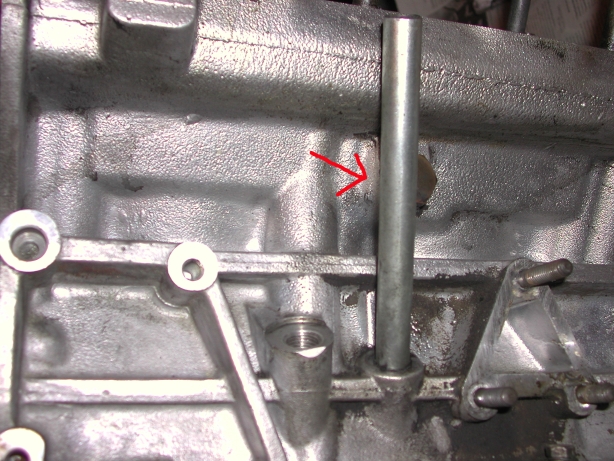
Oil Level Sensor
In the article David says: The hole was plugged with a
brass adapter, silver soldered shut. The later 2.5 engines have a plug screwed
in this hole so that can be used instead. My donor 2.5 did not have this hole
drilled and threaded in the engine block.
Well, as you can see from the pictures above, nothing special here in my case. Just moved the sensor
from the Verde block over to the 164 block.
164 Distributor Hole
Now here is one that I found interesting, in the article David had to fabricate a cover plate for the hole
left by removing the 164 distributor. The weird thing is that the Verde
engine already had one, what the heck? At first I thought perhaps someone
had already put a 164 engine in my Verde sometime in the distant past so I
looked on the Verde parts microfiche and lo and behold...the cover was on it!
So for this all I had to do was to transfer mine over. Here's a pic of it
still on the Verde head.
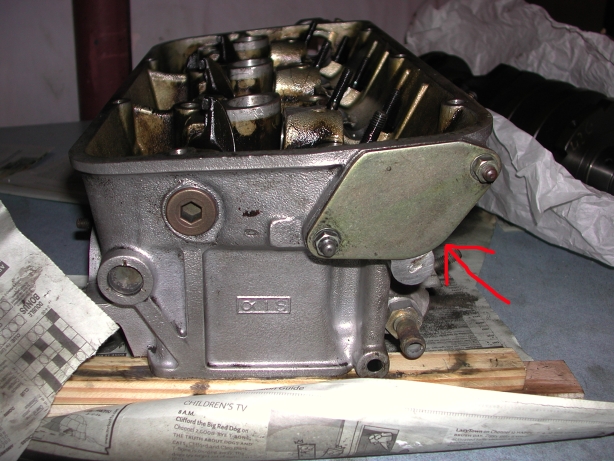
Rear Heater Hose Adaptor
This item turned out to be one of the biggest headaches for me in this conversion (we'll get to the other one
later!). In the article David states:
The 3.0L heater hose adapter
is a larger diameter than the 2.5L. This was replaced with a brass adapter and
nut & tail to suit the 2.5L hose size. The original steel adapter was a real
problem to remove. Eventually I filed through the top section to the thread and
bent it inwards to remove it.
Well, it isn't just the 3.0L to 2.5L difference, it is much smaller on the Verde 3.0L as well. You can see
the Verde on on just below the distributor hole cap in the picture above.
Here is a picture of the one from the 164 (this is David's picture, I forgot to
take a picture of mine. The article made it seem that it would be easy to
find an adaptor to fit so I went at the pipe with an air chisel to split it and
that worked to the side of the head. I then had to use a hack saw blade to
cut through most of it and then catch the lip still sticking out with a
screwdriver and hammer it towards the center. This pulled it out of the
threads enough so I could get it out. After I got it out I measured the
somewhat mangled piece and found that it seemed to be an oddball 19mm!
Dang, never going to find something like that! I trolled around the
internet trying to find an e-mail for anyone that had done this before but was
not able to get any facts on what they had done. I wasn't able to locate
David's e-mail address. After many days of cursing and pondering what to do (as
well as looking through the selection of adaptors at the local ACE and Home
Depot I decided that I had no option left but to drill and tap a standard size
hole and thread. What I ended up doing was going to a local tool store
that I go to when I need oddball stuff, especially on a Saturday (http://cgi3.ebay.com/ws/eBayISAPI.dll?ViewUserPage&userid=tlfxr1)
and bought a 23/32" drill bit and a 1/2" x 14 NPT pipe tap. I then turned
the engine on its end on the stand with the hole facing the floor and carefully
drilled it out with the new bit, it didn't really take much off but it made the
tapping easier. I then used the pipe tap to thread it. I then
carefully vacuumed out any remaining aluminum shavings. I bought a
standard pipe nipple adaptor from ACE (see pic below), put some silicone sealant
on the threads and screwed it in. Remember that the NPT thread is actually
tapered so the farther you screw it in the tighter it gets.

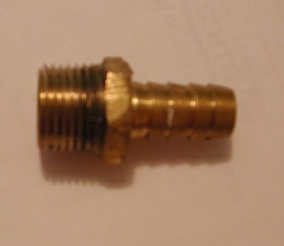
In hindsight I think I would have left the 164 hose connector alone and would have tried to find some sort of
adaptor combination to get the heater hose to connect up to it!
Starter Motor
In the article it stated that some slight modifications were needed to get the starter to bolt up, I didn't
have to make any mods, it fit with no problems.
A/C Compressor
In the article it stated that some slight modifications were needed to get the A/C compressor to bolt up, I
didn't have to make any mods, it fit with no problems.
Bell housing rear engine mount
It fit with no problems.
Aux Air Valve
In the article David used the cam covers from the 164 so had to drill & tap some holes for the AAV, I just
used the covers from the Verde (the nice wrinkle painted ones from an earlier
chapter) so didn't need to do this.
Fuel rail, injectors, plenum
In the article David did a bunch of flow improvement mods to the plenum and runners. I didn't have
any interest in doing that at this time so just used the fuel rail, injector,
and intake plenum from the Verde. As previously I did have the injectors
cleaned and tested (http://www.cruzinperformance.com/fuelinj.html), one was
found to be bad and was replaced with one from the Platinum we parted out.
It was a good thing I did that, take a look at the condition of the injector
hoses! At first I bought the expensive set of hose/end caps/clamps from
IAP for $14.50 per two injectors but then decided to return them and just use
the old end caps and a length of high pressure fuel hose (from IAP, all the
local yocals would sell you low pressure stuff and say it was fine for higher
pressures!). No clamps needed, you'll see what I mean if you ever try to
get these little hoses off! MUCH cheaper that way, $2.90 for a foot vs.
$14.50 x 3! I had destroyed all the little hoses getting them off so I
didn't know what length they were supposed to be so Greg Gordon was kind enough
to inform me that they should be 34mm each.
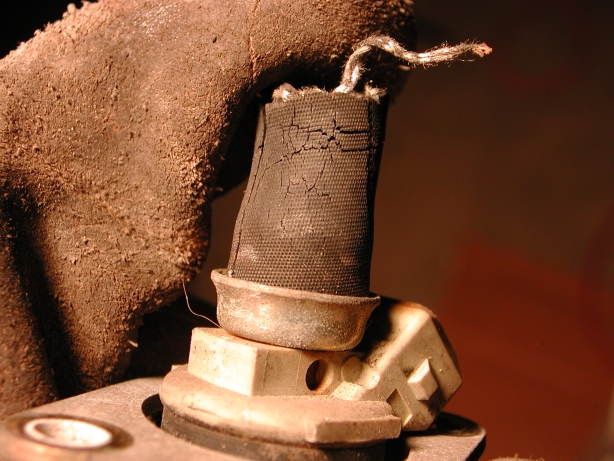
Other Stuff
You have to swap the crank pulley and water pump as the 164 used ribbed belts going lengthwise around the
belt instead of across. Make sure to remove the sensor for the 164 pulley
as well. Hold on to it as I've heard it might be useful if you decide to
use a MegaSquirt FI system. The alternator fit with no issues. The
distributor from the Verde fits with no problems after you remove the cap on the
164 engine for where it goes. Just make sure to use a matching gear set.
Timing Belt De-tensioner
OK, now as previously promised, we get to the biggest pain for my conversion. I'm assuming that the vast
majority of engines will not have this problem but it had me stumped for a
couple weeks trying to figure out what happened. In fact you may have seen
my various questions on the alfa digest mailing list and/or the alfabb web site.
This was made all the more difficult as I had never installed a de-tensioner yet
(I had this done by Tom Sahines son in CA before I drove the car to Seattle for
last years convention and then home to NH) so didn't know what to expect.
I installed it as specified in the directions on various web sites and just
could not get the pointer to point at the mark. Upon closer inspection of
the tensioner that had been on the 164, which has a broken spring (I might have
broken it taking it off), I noticed that someone had modified the holes that go
over the studs! I put that one back on and was able to get it adjusted
properly with no problem! Dang! Here are some pics of the old and
new tensioners and a line trace showing the difference.
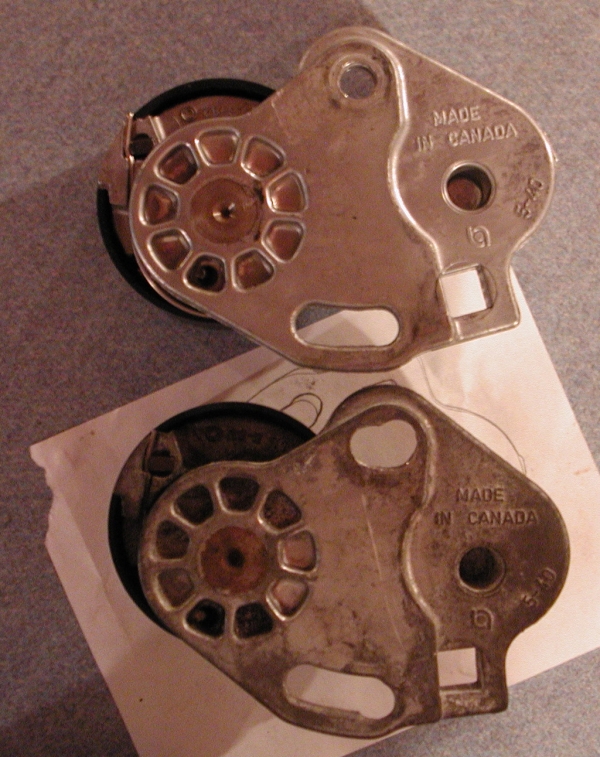
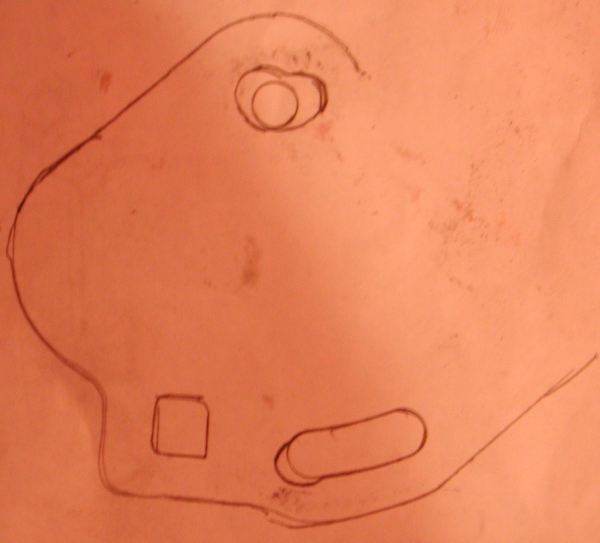
I started to measure a bunch of different reference points and could not find any significant differences.
I measured the thickness of the heads and they were very close if not the same.
The caliper I was using was not accurate enough to really tell but there was not
a significant difference. I just couldn't figure it out and no one in
either alfa resource was able to think of anything else to try. The
measuring was made a little difficult since the 164 engine was almost done while
the Verde engine was in pieces except for those parts on the 164 engine.
After a couple weeks of measuring and querying I was not able to figure out
anything else new to try. I tried to get the info on the previous owner
prior to the shop but the shop had given away that info when they sent the
unused parts of the car to the junkyard. I couldn't use the old tensioner
as the spring was broken so I ended up making a jig to hold it steady in
position on my drill press and (yikes!) drilled matching holes. I was then
able to install it and have it adjust properly.
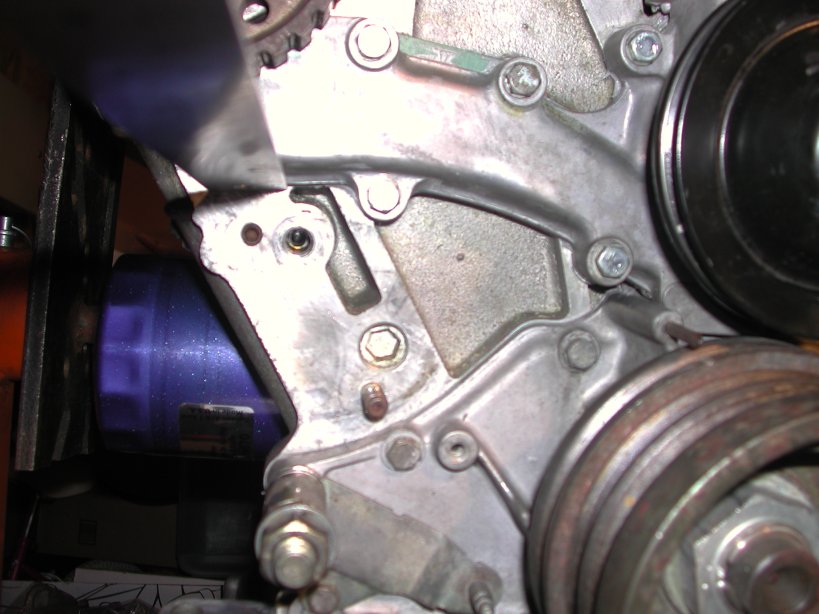
164 block I'm trying to get running

Verde's original block with the 164 water pump on it for reference
Couple More Mods
In the down time while I was trying to figure out what to do with the de-tensioner I decided to "fix" a
couple other things on the Verde.
In recent years I've grown very accustomed to keyless entry and remote trunk pops. No point in doing this
on the spider (except maybe the trunk pop) but on the Verde I thought it would
be a very useful and "hidden" upgrade. I had found a post on the alfabb on
the subject where the poster was kind enough to specify the exact things to
order (http://www.alfabb.com/bb/forums/showthread.php?t=23135).
Just in case any of that gets lost here is the info again:
For the keyless entry
system, I used a Bulldog Security KE1702-ENG-CL, which I got from Amazon for
$42. I chose this one because their webpage (www.bulldogsecurity.com)
actually had wiring information for a Milano. And believe it or not, it was
correct! The power lock module is located above the fuse panel, behind that
little glove box to the left of the steering wheel. I just wired up the keyless
entry box according to the color codes on the Bulldog webpage, and everything
worked the first time.
For the power trunk release, I first bought a cheapie $15 solenoid kit. It
didn't have enough power to pop the latch, so then I found the much more
powerful Spal SIL40K solenoid. I got it from
www.a1electric.com for
$45. It fits nicely in a recess under the trunk carpet between the latch and the
left side light assembly. It has plenty of power, but you need to run a 12 gauge
wire. I connected a new wire to a spare unfused lug on the back of the fuse
panel (look for the 10gauge red wires), added an inline fuse and relay and ran
the wire under the carpet back to the trunk.
I used these same units with good success. Here is a pic of the solenoid installation:
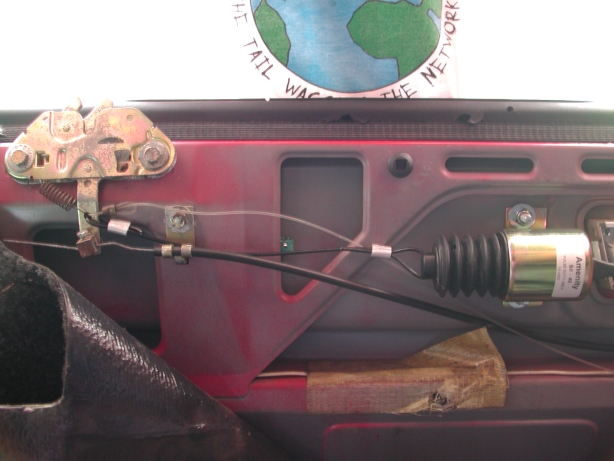
Here is a pic of the power lock control unit that comes with the Milano's. This is where you need to splice in some of the wires from the keyless receiver unit. The whole mess is then stuff in behind the little cubby there with the screw for the power lock control unit being used for the ground connection.

I installed all this stuff when the engine was out and therefore no battery in so I had no way to test it.
Much to my surprise when I finally got all that back in both worked perfectly
the first time!
The other mod I did was to the radio antenna. I had a power antenna in there that I am not sure if it was
the original one or not but it didn't work. The one I took from the parted
Platinum also did not work! I did a little searching on the Internet and
was appalled at how often they break and how expensive they were so I looked
around for an alternative. I found this one:
http://www.antennax.com/products/Description_ax02.htm. On some of the
example cars it looked decent and I figured it was worth a shot for $14.99.
I think this guy sells on e-bay as well. I had to make the hole for the
antenna a little larger, the instructions call for 1" but that is too big for
the Milano's as it will extend out beyond the crease in the metal. If you
play with it a bit you can make an odd shaped hole that fits within the crease
bounds and that the antenna fits in no problem. Here's a couple pics of it on the Verde:
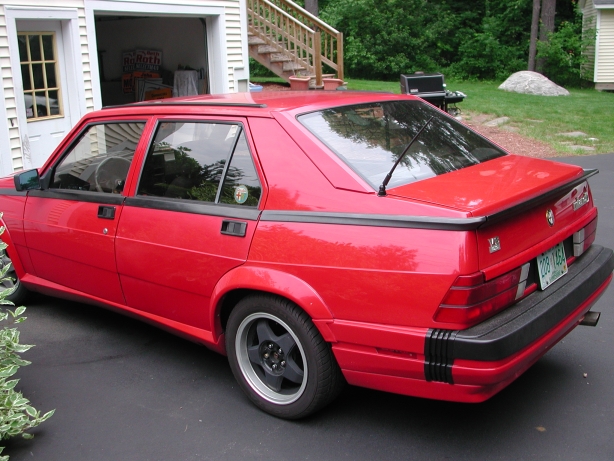
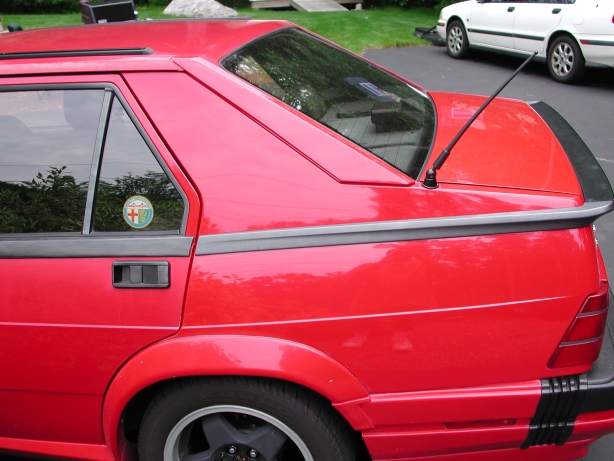
I'm not sure how well it works compared to the original one yet as I'm more entertained listening to the engine!
Update 11/17/12: Turns out that antenna doesn't get very good reception, it looks nice but sucks.
I ended up pulling it out and replacing it with a good powered antenna from a parts car I got later.
And now for the final pic of the completed engine bay!
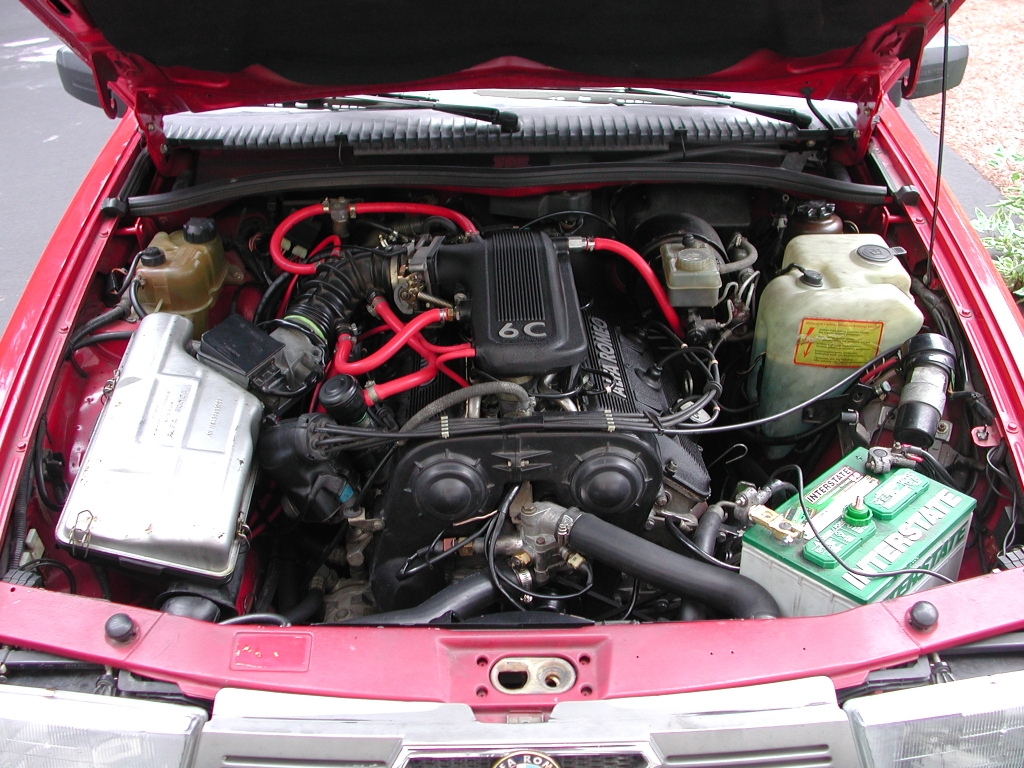
Over the past few days I've been driving the snot out of it and I now remember intently what I was missing.
I used the rear muffler from the parts platinum which appears to be stainless
steel, is in great condition, and has a much throatier sound than stock, very nice!
One issue has cropped up and it seems that the driveshaft support bearing might be bad, it's a little hard to
tell but I think that is what is making noise. At first it sounded like
the heat shield was loose and vibrating but upon inspection it was securely
screwed in. Just to be sure I took it off and the sound was still there
and does appear to be coming from the support bracket area. This is
somewhat annoying because I rebuilt that with a new bearing and support hanger
since I had the driveshaft off! While I'm on that topic I did have some
issues trying to get the recessed nut off so I could get the center support
changed. The nut was a 32mm and it needed a deep socket to reach it and
all the sockets that fit the bill were way to thick to get into the recessed
area. I ended up buying a cheapo 32mm socket and then taking it to a local
machine shop and one of they guys put it on the lathe on during his lunch break
and thinned the top wall a bit for $20 (twice the price of the socket but it
worked perfectly!). Here's a shot of it:

Well hopefully I'll sort out the driveshaft support issue soon, after that a few other minor issues. I hope you found this useful. If I end up rebuilding the original engine as originally intended I'll keep a journal on that but for now, get out and drive those Alfa's!
Week 1: Jan 21, 2006 - Preparing to remove the engine
Week 2: Jan 28, 2006 - Getting the engine out of the car
Week 3: Feb 04, 2006 - Removal of the heads and oil pan
Week 4: Feb 11, 2006 - Removal of the pistons and crankshaft
Week 5: Feb 13, 2006 - Mar 26, 2006 - Much time passes with little rebuild progress...but got other stuff done
Finishing Up: Jul 02, 2006 - Much more time passes but finally finished!